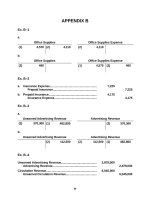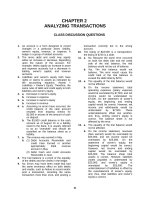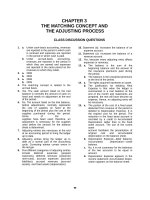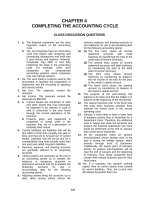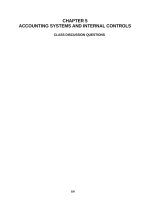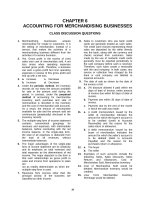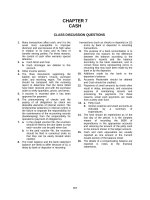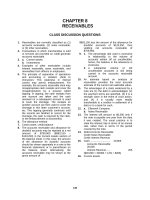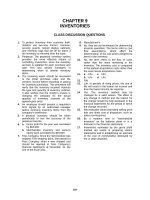Solution manual accounting 21e by warreni ch 24
Bạn đang xem bản rút gọn của tài liệu. Xem và tải ngay bản đầy đủ của tài liệu tại đây (153.86 KB, 44 trang )
CHAPTER 24
DIFFERENTIAL ANALYSIS AND
PRODUCT PRICING
CLASS DISCUSSION QUESTIONS
1. a. Differential revenue is the amount of
increase or decrease in revenue
expected from a particular course of
action compared with an alternative.
b. Differential cost is the amount of
increase or decrease in cost expected
from a particular course of action
compared with an alternative.
c. Differential income is the difference
between differential revenue and
differential cost.
2. This decision is an example of a make vs.
buy decision. Exabyte is focusing on its
comparative advantages, which include
marketing and distribution, while building
partnerships with others to actually
manufacture key elements of the product.
3. In the long run, the normal selling price
must be set high enough to cover all costs
(both fixed and variable) and provide a
reasonable amount for profit.
4. The differential income and costs of the
lease option should be compared against
selling the building. The differential revenue
would be the lease revenue compared to
the proceeds from sale. The differential
expenses would be the costs associated
with leasing the building, including
maintenance, property tax, and insurance
compared to the expense of selling, such
as sales commissions. The opportunity
cost of money should also be considered in
the analysis.
5. Assuming there is demand for the premium
grade product, this would assume the
differential price (premium less commodity)
exceeded the differential cost to process
the product to premium grade.
6. A business should only accept business at
a special price if the lower price will not
contaminate the regular pricing for other
customers or induce other customers to
buy at the special price. In addition, the
business must be careful not to violate the
Robinson-Patman Act, which prohibits
uncompetitive price differences across
7.
8.
9.
10.
11.
51
different markets for the same product.
Lastly, the company may only offer the
special price once for an incremental order.
Thus, the business must consider the
longer-term
ramifications
of
offering
discount business to a customer that may
wish to order in the future.
It would be reasonable to purchase from
the supplier if the fixed cost per unit was
less than 40 cents. That is, if the fixed cost
were less than 40 cents per unit, then the
variable cost per unit would exceed the
supplier’s price, making the supplier price
more attractive.
Some of the financial considerations
include the profitability of the store,
including all the revenues, variable and
fixed costs associated with the store, since
they would all be differential to the
decision. In addition, any costs of closing
the store and preparing the store for
disposal would need to be considered
(legal costs, demolition costs, employee
severance costs). Lastly, the opportunity
cost of the value of the equipment and land
(either in cash or rental income) should be
considered. For example, if the opportunity
value of the assets were $500 per month,
then the store would need to have a
profitability exceeding this amount to
remain an attractive alternative.
The use of ideal standards might not allow
for such factors as normal spoilage or
normal periods of idle time, with the result
that these costs might not be covered by
the product price. In such cases, the
product price could be too low to earn a
desired profit.
In setting prices, managers should also
consider such factors as the prices of
competing products and the general
economic conditions of the marketplace.
Activity-based costing can be used to
determine the product cost in a complex
manufacturing setting.
12.
The target cost concept begins with a price
that can be sustained in the marketplace,
then subtracts a target profit, thus
determining the target cost. The cost is
made to conform to the price required in
the market. In contrast, under cost plus, a
markup is added to the cost. The resulting
price is assumed to be acceptable in the
market.
13. The target cost concept is most appropriate
in highly competitive product markets,
where margins are under pressure and
prices are falling.
14. A production bottleneck is a point in the
production process where demand exceeds
the ability to produce (i.e., the segment is
operating at full capacity). As a result, the
complete production system output is
limited by the output of the bottleneck.
15. The proper measure of product value in a
bottlenecked process is the contribution
margin per bottleneck hour.
52
EXERCISES
Ex. 24–1
a.
Proposal to Lease or Sell Machinery
January 3, 2006
Differential revenue from alternatives:
Revenue from lease...................................................
Proceeds from sale....................................................
Differential revenue from lease.............................
Differential cost of alternatives:
Repair, insurance, and property tax expenses.........
Commission on sale..................................................
Differential cost of lease.......................................
Net differential income from lease alternative.............
$200,000
180,000
$ 20,000
$ 24,000
9,000
15,000
$ 5,000
b. Lease the machinery. The net gain from leasing is $5,000.
Ex. 24–2
a.
Proposal to Discontinue Diet Kola
January 3, 2006
Differential revenue from annual sales of Diet Kola:
Revenue from sales.....................................................
Differential cost of annual sales of Diet Kola:
Variable cost of goods sold.........................................
Variable operating expenses.......................................
Annual differential income from sales of Diet Kola.......
* 258,000 × 80%
$ 486,000
$206,400*
195,000**
401,400
$ 84,600
** 260,000 × 75%
b. Diet Kola should be retained. As indicated by the differential analysis in (a),
the income would decrease by $84,600 (excess of differential revenue over
differential cost) if the product is discontinued.
53
Ex. 24–3
a.
CENTURY CERAMICS COMPANY
Differential Product Analysis Report
For the Year Ended December 31, 2006
Differential revenue from annual sales:
Revenue from sales................................
Differential costs of annual sales:
Variable cost of goods sold....................
Variable selling and administrative
expenses..............................................
Annual differential income from sales.......
Bowls
Plates
Cups
$ 96,000
$ 122,000
$ 79,000
$ 41,820
$ 55,760
$ 41,820
19,600
$ 61,420
21,700
$ 77,460
23,800
$ 65,620
$ 34,580
$ 44,540
$ 13,380
b. The Cups line should be retained. As indicated by the differential analysis in
(a), the income would decrease by $13,380 (excess of differential revenue
over differential cost) if the Cups line is discontinued.
54
Ex. 24–4
Note to Instructors: Many students may be unfamiliar with the financial services
industry. This exercise provides an opportunity to introduce students to some
basic terms and concepts used within the industry.
a.
The “Individual Investor” segment serves the retail customer, you and me.
These are the brokerage, Internet, and mutual fund services used by
individual investors. The “Institutional Investor” segment includes the same
services provided for financial institutions, such as banks, mutual fund
managers, insurance companies, and pension plan administrators. Although
not required by the question, the “Capital Markets” segment provides
wholesale trade execution services on the major exchanges and broker/dealer
networks.
b. Variable costs in the “Individual Investor” segment:
1. Commissions to brokers
2. Fees paid to exchanges for executing trades
3. Transaction fees incurred by Schwab mutual funds to purchase and sell
shares
4. Advertising
Fixed costs in the “Individual Investor” segment:
1. Depreciation on brokerage offices
2. Depreciation on brokerage office equipment, such as computers and
computer networks
3. Property taxes on brokerage offices
c.
Income from operations.............................
Plus: Depreciation.......................................
Estimated contribution margin...................
Individual
Investor
Institutional
Investor
Capital
Markets
$245
294
$539
$272
51
$323
$ 18
26
$ 44
d. If one assumes that the fixed costs that serve institutional investors
(computers, servers, and facilities) would not be sold but would be used by
the other two sectors, then the contribution margin of $323 million would be
an estimate of the reduced profitability. If the fixed assets were sold, then the
operating income decline would approach $272 million. Since the institutional
and retail investors use nearly the same assets, the $323 million answer is
probably the better estimate.
55
Ex. 24–5
The flaw in the decision was the failure to focus on the differential revenues and
costs, which indicate that operating income would be reduced by $20,000 if
Children’s Shoes is discontinued. This differential income from sales of
Children’s Shoes can be determined as follows:
Differential revenue from annual sales of Children’s
Shoes:
Revenue from sales......................................................
Differential cost of annual sales of Children’s Shoes:
Variable cost of goods sold..........................................
Variable operating expenses........................................
Annual differential income from sales of Children’s
Shoes.............................................................................
$130,000
$90,000
20,000
110,000
$ 20,000
Ex. 24–6
a.
Proposal to Manufacture Carrying Case
June 5, 2006
Purchase price of carrying case...................................
Differential cost to manufacture carrying case:
Direct materials..........................................................
Direct labor.................................................................
Variable factory overhead.........................................
Cost savings from manufacturing carrying case........
$51.00
$20.00
24.00
6.00
50.00
$ 1.00
b. It would be advisable to manufacture the carrying cases because the cost
savings would be $1.00 per unit. Fixed factory overhead is irrelevant, since it
will continue whether the carrying cases are purchased or manufactured.
56
Ex. 24–7
a.
Proposal to Purchase Outside Layout Services
December 15, 2005
Differential revenue:
Salvage of computer equipment.....................................
Differential expenses:
Purchase price of layout work
Number of pages..........................................................
Price per page...............................................................
Total..................................................................................
Differential cost to perform internally
Salaries.........................................................................
Benefits.........................................................................
Supplies........................................................................
Office expenses............................................................
Cost savings from purchasing layout out services.......
Total benefit from using an outside service...................
$
6,000
18,000
× $16.00
$288,000
$200,000
40,000
35,000
20,000
295,000
$ (7,000)
$ 13,000
b. The benefit from using an outside service is shown to be $13,000 greater than
performing the layout work internally. The fixed costs in the budget are
irrelevant to the decision. Thus, the work should be purchased from the
outside on a strictly financial basis. In addition, the decision to purchase from
the outside would be further favored if the need for administrative expansion
space were great. If more administrative space were needed immediately, then
any additional lease costs would become a differential benefit to the decision
to outsource.
c. Before electing to terminate the five employees the association should
consider the long-run impact of the decision. Specifically, future page layout
rates may grow faster than the cost of internal salaries, thus favoring the use
of employees over the long-term. This would especially be the case if the
outside company provided a low bid in order to win the initial business. In
addition, the association may wish to consider non-economic factors such as
the ability to more directly control the quality and timing of the layout work by
internal employees.
57
Ex. 24–8
a.
Annual variable costs—present equipment................
Annual variable costs—new equipment......................
Annual differential decrease in cost............................
Number of years applicable..........................................
Total differential decrease in cost................................
Proceeds from sale of present equipment..................
Cost of new equipment.................................................
Net differential income, 6-year total.............................
Annual differential income from new equipment
($60,000 ÷ 6)...............................................................
$ 160,000
90,000
$ 70,000
×
6
$ 420,000
85,000
$ 505,000
445,000
$ 60,000
$ 10,000
b. The sunk cost is the $220,000 book value ($520,000 cost less $300,000
accumulated depreciation) of the present equipment. The original cost and
accumulated depreciation were incurred in the past and are irrelevant to the
decision to replace the machine.
58
Ex. 24–9
a.
Proposal to Replace Machine
January 20, 2006
Annual costs and expenses—present machine...............................
Annual costs and expenses—new machine.....................................
Annual differential decrease in costs and expenses.......................
Number of years applicable...............................................................
Total differential decrease in costs and expenses...........................
Cost of new equipment......................................................................
Net differential increase in costs and expenses, 10-year total........
$213,000
192,500
$ 20,500*
×
10
$205,000
225,000
$ 20,000
Annual differential increase in costs and expenses—new machine
$
2,000
*The annual differential decrease in costs and expenses could be computed
alternatively as follows:
Decrease in direct labor costs......................................
Less: Increase in power and maintenance.................
Increase in taxes, insurance, etc......................
Annual differential decrease in costs and expenses. .
$ 43,500
$20,000
3,000
23,000
$ 20,500
b. The proposal should not be accepted.
c. In addition to the factors given, consideration should be given to such factors
as: Do both present and proposed operations provide the same capacity?
What are the opportunity costs associated with alternative uses of the
$225,000 outlay required to purchase the automatic machine? Is the product
improved by using automatic machinery? Does the federal income tax have
an effect on the decision?
Ex. 24–10
a.
Differential revenue: $820 – $615 = $205
b. Differential cost: $560 – $445 = $115
c. Differential income: $205 – $115 = $90
59
Ex. 24–11
a.
Proposal to Process Columbian Coffee Further
Differential revenue from further processing per batch:
Revenue from sale of Decaf Columbian
[(8,000 pounds – 400 pounds evaporation) × $11.20........ $85,120
Revenue from sale of Columbian Coffee
(8,000 pounds × $8.80).......................................................
70,400
Differential revenue..................................................................
$ 14,720
Differential cost per batch:
Additional cost of producing Decaf Columbian...............
18,520
Differential loss from further processing:
Decaf Columbian per batch................................................
$
(3,800)
b. The differential revenue from processing further to Decaf Columbian is less
than the differential cost of processing further. Thus, AM Coffee Company
should sell Columbian Coffee and not process further to Decaf Columbian.
c. The price of Decaf Columbian would need to increase to $11.70 per pound in
order for the differential analysis to yield neither an advantage or
disadvantage (indifference). This is determined as follows:
$3,800
Net disadvantage of further processing
=
= 0.50
7,600 pounds
Volume of Decaf Columbian
The price of Decaf Columbian would need to be $0.50 higher, or $11.70, to
yield no net differential income or loss. This is verified by the following
differential analysis:
Differential revenue from further processing per batch:
Revenue from sale of Decaf Columbian [(8,000
pounds – 400 pounds evaporation) × $11.70]................... $88,920
Revenue from sale of Columbian Coffee
(8,000 pounds × $8.80).......................................................
70,400
Differential revenue.............................................................
$ 18,520
Differential cost per batch:
Additional cost of producing Decaf Columbian...............
18,520
Differential income from further processing:
Decaf Columbian per batch................................................
$
0
60
Ex. 24–12
a.
Proposal to Sell to Barker Company
January 18, 2006
Differential revenue from accepting the offer:
Revenue from sale of 13,000 additional units at $28..................
Differential cost of accepting the offer:
Variable costs from sale of 13,000 additional units at $21..........
Differential income from accepting the offer....................................
$364,000
273,000
$ 91,000
b. The additional units can be sold for $28 each, and since unused capacity is
available, the only costs that would be added if this additional production
were accepted are the variable costs of $21 per unit. The differential revenue
is therefore $28 per unit, and the differential cost is $21 per unit. Thus, the net
gain is $7 per unit × 13,000 units, or $91,000.
c. $21.01. Any selling price above $21 (variable costs per unit) will produce a
positive contribution margin.
Ex. 24–13
$17.80 [($416,000 – $60,000) ÷ 20,000 batteries]. The lowest bid should cover all
variable costs.
61
Ex. 24–14
a.
Proposal to Sell to Continental Motors
August 4, 2006
Differential revenue from accepting special offer....
Differential costs from accepting special offer:
Direct materials.......................................................
Direct labor..............................................................
Variable factory overhead.......................................
Variable selling and administrative........................
Less: Avoided sales commission..........................
Additional shipping costs......................................
Variable landed product cost.................................
Incremental certification costs..................................
Total differential costs................................................
Differential income from accepting special order....
Per Unit
Total
$70.00
$ 1,400,000*
$30.00
12.00
7.20
7.50
(4.50)**
4.00
$56.20
$ 1,124,000
140,000
$ 1,264,000
$ 136,000
*$70 × 20,000 units
**The avoided sales commission should not be computed on the basis of the
$70 price to Continental Motors. That is, the variable selling and
administrative cost for the special order is $3.00, which is the amount
remaining after removing the existing sales commission.
b.
$1,264,000
= $63.20
20,000 units
or
$70 –
$136,000
= $63.20
20,000 units
62
Ex. 24–15
a.
$100,000 ($400,000 × 25%)
b. Total costs:
Variable ($220 × 4,000 units).............................................................. $ 880,000
Fixed ($160,000 + $80,000).................................................................
240,000
Total..................................................................................................... $ 1,120,000
Cost amount per unit: $1,120,000 ÷ 4,000 units = $280
c.
Markup percentage =
Desired profit
Total costs
Markup percentage =
$100,000
$1,120,000
Markup percentage =
8.93% (rounded)
d. Cost amount per unit..........................................................................
Markup ($280 × 8.93%)........................................................................
Selling price........................................................................................
$280
25
$305
Ex. 24–16
a.
Total manufacturing costs:
Variable ($205 × 4,000 units).........................................................
Fixed factory overhead.................................................................
Total................................................................................................
$820,000
160,000
$980,000
Cost amount per unit: $980,000 ÷ 4,000 units = $245
b.
Desired profit + Total selling and administrative expenses
Markup
percentage =
Total manufacturing costs
Markup percentage =
$100,000 $80,000 + ($15 × 4,000 units)
$980,000
Markup percentage =
$100,000 + $80,000 + $60,000
$980,000
Markup percentage =
$240,000
$980,000
Markup percentage = 24.49% (rounded)
c.
Cost amount per unit..........................................................................
Markup ($245 × 24.49%).....................................................................
Selling price........................................................................................
63
$245.00
60.00
$305.00
Ex. 24–17
a.
Total variable costs: $220 × 4,000 units............................................
Cost amount per unit: $880,000 ÷ 4,000 units = $220
b. Markup percentage =
$880,000
Desired profit + Total fixed costs
Total variable costs
Markup percentage =
$100,000 + $160,000 + $80,000
$880,000
Markup percentage =
$340,000
$880,000
Markup percentage = 38.64% (rounded)
c.
Cost amount per unit..........................................................................
Markup ($220 × 38.64%)......................................................................
Selling price........................................................................................
$220.00
85.00
$305.00
Ex. 24–18
a.
The price will be set at the estimated market price required to remain
competitive, or $36,000. Under the target cost concept, the market dictates
the price, not the markup on cost.
b. The required profit margin of 20% of the estimated $36,000 price implies a
$28,800 target product cost as follows:
Target Product Cost = $36,000 – ($36,000 × 20%)
Target Product Cost = $36,000 – $7,200
Target Product Cost = $28,800
Since the estimated manufacturing cost of $29,500 exceeds the target cost of
$28,800, Toyota will try to remove $700 from its manufacturing costs in order
to maintain competitive pricing within its profit objectives.
Note to Instructors: Target costing provides pressure to keep costs
competitive. The method assumes that the company may not be able to
successfully add a markup to its costs because the resulting price may be
too high in the marketplace. For example, merely adding the 25% markup on
the $29,500 product cost would result in an uncompetitive price of $36,875.
The target cost concept moves backwards by taking the price as given and
then determines the cost that is required for a given profit objective.
64
Ex. 24–19
a.
Historical markup percentage:
$300 -- $240
= 25%
$240
$285 -- X
= 25%
X
$285 – X = 0.25X
$285 = 1.25X
X = $228
Target cost: $228
Target cost:
b. Required cost reduction: $240 – $228 = $12
c.
1. Direct labor reduction:
6 min.
× $20 =
60 min.
3 min.
× $20 =
60 min.
Direct material reduction:
3. Injection molding productivity improvement:
Direct labor improvement (25%* × 25% × $40)
Factory overhead improvement (25%* × 40% ×
$30)
Total savings
2. Additional inspection:
$ 2.00
$(1.00)
5.00
4.00
$ 2.50
3.00
5.50
$11.50
*Improving the cycle time from four minutes to three minutes is a 25%
reduction.
The total savings are 50 cents short of the cost reductions required to hit the
target cost. More improvements will need to be discovered.
65
Ex. 24–20
Determine the contribution margin per furnace hour as follows:
Contribution Margin Per Unit
A
B
C
Revenue per unit (divided by 2,000).................
Variable cost per unit (divided by 2,000)..........
Contribution margin per unit.............................
7.50
4.00
3.50
9.00
4.50
4.50
7.00
3.00
4.00
*Contribution margin per furnace hour............
0.70
0.50
0.40
*Calculated as follows:
A:
$3.50
= $0.70 per furnace hour
5 hours
B:
$4.50
= $0.50 per furnace hour
9 hours
C:
$4.00
= $0.40 per furnace hour
10 hours
Emphasize Product A. In a production-constrained environment, Product A
generates the most contribution margin per hour of furnace resource, and thus, is
the most profitable. While Product B has the largest profit per unit ($2.50) and
contribution margin per unit ($4.50), these would not be the correct metrics for
determining the product to emphasize in the marketing campaign.
66
Ex. 24–21
a.
Large
Small
Medium
Total
Units produced........................
2,000
2,000
2,000
Revenues.................................
Less: Variable costs................
Contribution margin................
Less: Fixed costs....................
Income from operations..........
$460,000
244,000
$216,000
$380,000
170,000
$210,000
$210,000
110,000
$100,000
$1,050,000
524,000
$ 526,000
450,000
$ 76,000
b. The Large glass product is the most profitable, demonstrated as follows:
Contribution margin per unit..........................
Autoclave hours per unit................................
Contribution margin per bottleneck hour......
67
Large
Medium
Small
$ 108
÷
8
$13.50
$ 105
÷ 10
$10.50
$ 50
÷
5
$10.00
Ex. 24–22
Large is the highest profit item, since it produces more contribution margin per
autoclave hour. The prices of Medium and Small would need to be increased in
order to match Large’s profitability. The two calculations are as follows:
Revised price of Medium:
Contribution margin
per bottleneck hour
of Large
=
Revised price -- Variable cost per unit
of Medium
of Medium
Bottleneck hours per unit of Medium
$13.50
=
Revised price of Medium -- $85
10 hours
$135
=
Revised price of Medium – $85
$220
=
Revised price of Medium
Contribution margin
per bottleneck hour
of Large
=
Revised price -- Variable cost per unit
of Small
of Small
Bottleneck hours per unit of Small
$13.50
=
Revised price of Small -5 hours
$67.50
=
Revised price of Small – $55
$122.50
=
Revised price of Small
Revised price of Small:
$55
Thus, prices of $220 for Medium and $122.50 for Small both produce a
contribution margin per hour of bottleneck operation of $13.50. The price of Large
would remain unchanged. At these prices, the company should be indifferent
about the product mix.
68
Appendix Ex. 24–23
Activity Base Usage
×
Activity
Rate
=
Stationary Bicycle
Fabrication
1,795 machine hours
× $24 per mach. hr.
Assembly
448 direct labor hours
× $12 per dlh.
Setup
45 setups
× $40 per setup
Inspecting
700 inspections
× $24 per inspection
Production scheduling 70 production orders
× $14 per prod. order
Purchasing
180 purchase orders
× $5 per purch. order
Total.................................................................................................................
Number of units..............................................................................................
Activity costs per unit....................................................................................
Activity
Cost
$43,080
5,376
1,800
16,800
980
900
$68,936
÷
800
$ 86.17
Rowing Machine
Fabrication
988 machine hours
× $24 per mach. hr.
$23,712
Assembly
176 direct labor hours
× $12 per dlh.
2,112
Setup
16 setups
× $40 per setup
640
Inspecting
400 inspections
× $24 per inspection
9,600
Production scheduling 12 production orders
× $14 per prod. order
168
Purchasing
120 purchase orders
× $5 per purch. order
600
Total................................................................................................................. $36,832
Number of units.............................................................................................. ÷
800
Activity costs per unit.................................................................................... $ 46.04
69
Appendix Ex. 24–24
a.
Production
Quality
Materials
Activity Rates
Setup
Procurement
Control
Management
Overhead cost... $
38,400 $ 126,000 $
150,000 $
120,000
Activity base..... ÷
480 ÷
1,200 ÷
2,500 ÷
400
Activity rate....... $ 80/Setup $ 105/P.O. $ 60/Inspection $300/Component
b.
Number of setups.....................
Rate per setup..........................
Custom
400
× $80
Standard
80
× $80
$ 32,000
Number of purchase orders.....
Rate per purchase order..........
1,000
× $105
Number of inspections.............
Rate per inspection..................
2,000
× $60
$
200
× $105
105,000
21,000
500
× $60
120,000
Number of components...........
Rate per component.................
300
× $300
30,000
100
× $300
90,000
$347,000
÷ 4,000
$ 86.75
Total product cost....................
Unit volume..............................
Unit cost..............................
6,400
30,000
$ 87,400
÷ 4,000
$ 21.85
c. The factory overhead allocated to each product on the basis of direct labor
hours would be 50%, since each product has the same 4,000 direct labor
hours. The factory overhead per direct labor hour for each product is
$434,400
= $54.30 per hour
8,000 hours
Since each product requires one direct labor hour, the cost per unit is also
$54.30 for each product.
d. The factory overhead allocated to the custom power unit is much higher
under the activity-based approach, compared to the direct labor method. The
reason is that the setup, procurement, and quality control activities are not
directly related to the number of direct labor hours but are instead related to
the number of setups, purchase orders, and inspections. In addition, the
custom product had a more complex design (more components) than does
the standard product. As a result, the custom product will consume more
materials management activities than will the standard product.
70
PROBLEMS
Prob. 24–1A
1.
Proposal to Operate Warehouse
December 1, 2006
Differential revenue from alternatives:
Revenue from operating warehouse........................ $2,870,0001
Revenue from investment in bonds.........................
672,0002
Differential revenue from operating warehouse. .
$2,198,000
Differential cost of alternatives:
Costs to operate warehouse..................................... $1,540,0003
Cost of equipment less residual value.....................
510,000
Differential cost of operating warehouse.............
2,050,000
Differential income from operating warehouse...........
$ 148,000
1
(7 yrs. × $230,000) + (7 yrs. × $180,000)
2
8% × $600,000 × 14 yrs.
3
$110,000 × 14 yrs.
2. The proposal should be accepted.
3.
Total estimated revenue from operating
warehouse..................................................................
Total estimated expenses to operate warehouse:
Costs to operate warehouse, excluding
depreciation........................................................... $1,540,000
Cost of equipment less residual value.....................
510,000
Total estimated income from operating
warehouse..................................................................
$2,870,000
2,050,000
$ 820,000*
*The $820,000 income from operations could also be determined by adding the
$148,000 gain from operating the warehouse as derived in (1) to the $672,000
of investment income forgone by electing to operate the warehouse.
71
Prob. 24–2A
1.
Proposal to Replace Machine
March 22, 2006
Annual manufacturing costs associated with present machine......
Annual manufacturing costs associated with proposed
new machine..................................................................................
Annual reduction in manufacturing costs.........................................
Number of years applicable................................................................
Cost reduction attributable to difference in manufacturing costs. .
Proceeds from sale of present machine............................................
$ 23,000
$
×
$
$
Cost of new machine..........................................................................
Differential income anticipated from replacement, 6-year total.......
$
10,000
13,000
6
78,000
54,000
132,000
114,000
18,000
2. Other factors to be considered include:
a. Are there any improvements in the quality of work turned out by the new
machine?
b. What effect does the federal income tax have on the decision?
c. What opportunities are available for the use of the $60,000 of funds
($114,000 less $54,000 sales price of old machine) that are required to
purchase the new machine?
After considering such factors as those listed above, the net cost reduction
anticipated over the 6-year period may not be sufficient to justify the
replacement. For example, if there is an opportunity to invest the $60,000
($114,000 – $54,000) of additional funds required for the replacement in a
project that earns a return of 6%, the amount of the return over the 6-year
period would be $21,600 ($60,000 × 6% × 6), which is more advantageous than
the replacement, other factors being equal.
72
Prob. 24–3A
1.
Proposals for Sales Promotion Campaign
March 3, 2006
Tennis Shoes Walking Shoes
Differential revenue from proposals..................
Differential cost of proposals:
Direct materials...............................................
Direct labor......................................................
Variable factory overhead...............................
Variable selling expenses...............................
Sales promotion expenses.............................
Differential cost of proposals.....................
Differential income from proposed sales
promotion campaign.......................................
1
2
$ 612,0001
$ 768,0002
$ 144,000
60,000
36,000
84,000
105,000
$ 429,000
$ 144,000
64,000
40,000
144,000
105,000
$ 497,000
$ 183,000
$ 271,000
6,000 shoes × $102
8,000 shoes × $96
2. The sales manager’s tentative decision should be opposed. The sales
manager erroneously considered the full unit costs instead of the differential
(additional) revenue and differential (additional) costs. An analysis similar to
that presented in (1) would lead to the selection of walking shoes for the
promotional campaign, since this alternative will contribute $88,000 more to
operating income than would be contributed by promoting tennis shoes.
73
Prob. 24–4A
1.
Proposal to Process Aluminum Ingot Further
February 20, 2006
Differential revenue from further processing per batch:
Revenue from sale of rolled aluminum
[(50 tons ÷ 1.125 tons) × $1,440]...........................
Revenue from sale of aluminum ingot
(50 tons × $920).....................................................
Differential revenue...............................................
Differential cost per batch:
Additional cost of processing rolled aluminum
(50 tons × $385).....................................................
Differential loss from further processing aluminum
ingot, per batch..........................................................
$64,000
46,000
$18,000
19,250
$ (1,250)
2. White Metals, Inc., should decide not to further process aluminum ingot to
produce rolled aluminum, since profits would be decreased by $1,250 per
batch.
74
Prob. 24–5A
1.
$150,000 ($1,000,000 × 15%)
2.
a. Total costs:
Variable ($50.00 × 20,000 units).................................................... $ 1,000,000
Fixed ($200,000 + $80,000)............................................................
280,000
Total................................................................................................ $ 1,280,000
Cost amount per unit: $1,280,000 ÷ 20,000 units......................... $
64.00
b. Markup percentage =
Markup percentage =
Desired profit
Total costs
$150,000
$1,280,000
Markup percentage = 11.72% (rounded)
c. Cost amount per unit.....................................................................
Markup ($64.00 × 11.72%)..............................................................
Selling price...................................................................................
3.
$64.00
7.50
$71.50
a. Total manufacturing costs:
Variable ($45 × 20,000 units)......................................................... $ 900,000
Fixed factory overhead.................................................................
200,000
Total................................................................................................ $ 1,100,000
Cost amount per unit: $1,100,000 ÷ 20,000 units......................... $
55.00
b. Markup percentage =
Desired profit + Total selling and administrative expenses
Total manufacturing costs
Markup percentage =
$150,000 + $80,000 + ($5 × 20,000 units)
$1,100,000
Markup percentage =
$150,000 + $80,000 + $100,000
$1,100,000
Markup percentage =
$330,000
$1,100,000
Markup percentage = 30%
c. Cost amount per unit.....................................................................
Markup ($55.00 × 30%)..................................................................
Selling price...................................................................................
75
$55.00
16.50
$71.50
